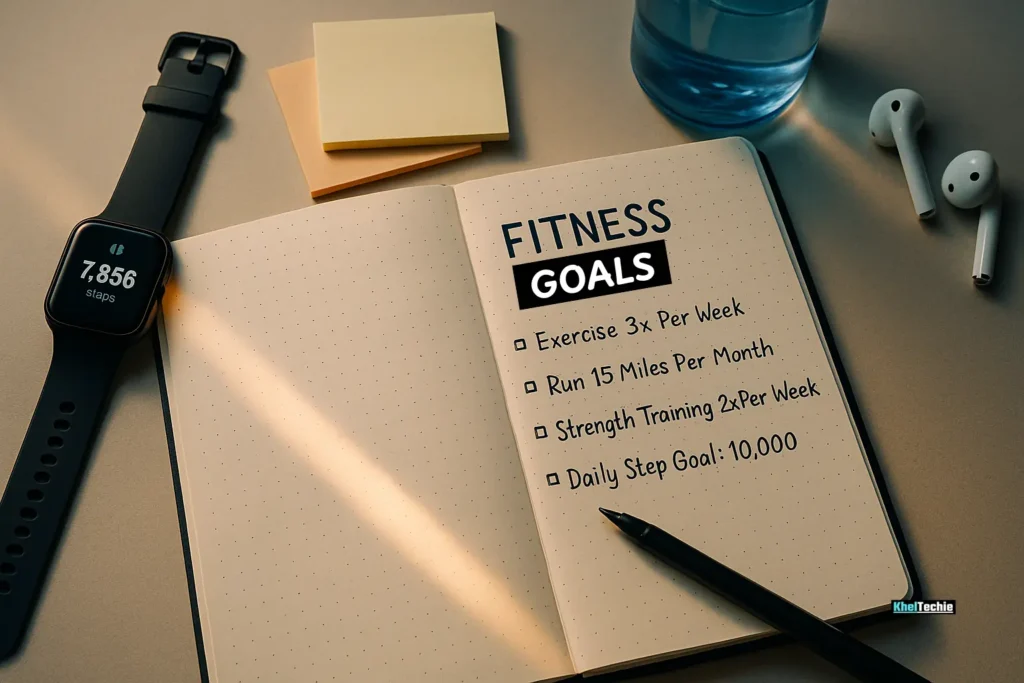How to Restart Your Fitness Journey After a Setback: Reignite Your Motivation
You’re Not Alone and You’re Not Starting Over
You’ve been there motivated, consistent, maybe even seeing results. Then life happened, injury, burnout, or a global pandemic. Now you’re staring at the mirror wondering, How do I start over without feeling like a total beginner?
Don’t worry, you’re not alone. And more importantly, you can get back on track. This guide will walk you through exactly how to restart your fitness journey after a setback, with practical steps, emotional support, and science-backed tips that actually work.
Also read – How to Create Personalized Workout Calendar

What Does It Mean to Restart Your Fitness Journey?
Restarting your fitness journey isn’t about punishment or perfection. It’s about re-engaging with your health goals in a way that honors your current reality. This phrase refers to the process of returning to physical activity, healthy eating, or general wellness after a disruption, whether it’s due to:
- Injury
- Illness
- Mental health struggles
- Life transitions (e.g., pregnancy, moving, job changes)
- Burnout or lack of motivation
Think of it like rebooting your system. You don’t have to erase all your progress, just recalibrate.

Why Restarting Your Fitness Journey Matters
Restarting your fitness journey after a setback can feel daunting, but recent research offers encouraging insights. A study published in the Scandinavian Journal of Medicine & Science in Sports found that taking a break from strength training doesn’t erase your previous gains. Thanks to muscle memory, your body retains the adaptations from prior workouts, allowing for a quicker rebound in muscle size and strength once you resume training. This means you’re not starting from scratch, your body remembers and responds efficiently.
Interestingly, the study found that while muscle size decreased during the break, strength was better preserved. This suggests that the nervous system retains strength capabilities even when muscle mass diminishes. Moreover, participants who took a break achieved similar results over time compared to those who trained continuously, highlighting that occasional pauses don’t derail long-term progress.
In essence, your previous fitness efforts have laid a foundation that your body can quickly rebuild upon. By coupling this advantage with mindful practices like timing your workouts to support restful sleep, you set yourself up for a successful and sustainable fitness comeback.

How to Restart Your Fitness Journey After a Setback
Let’s break this down into manageable, actionable steps.
Step 1: Reflect on What Caused the Setback
Before jumping into workouts, pause and ask yourself:
- Was it physical (injury, illness)?
- Emotional (stress, anxiety)?
- Environmental (lack of time, resources)?
Write down what caused the setback and how it made you feel. This helps you avoid repeating the same patterns.
Step 2: Reset Your Mindset
Motivation is fleeting, discipline and consistency come from mindset.
Key Strategies:
- Replace guilt with curiosity: “What can I learn from this?”
- Celebrate micro-wins: Did you go for a 10-minute walk? That’s a win.
- Use affirmations: “I’m not starting over, I’m continuing forward.”
The Expert says: “The most successful comeback athletes aren’t those with the strongest bodies, they’re those with the strongest minds.”
Step 3: Start Small and Slow
Jumping straight back into intense workouts often leads to injury or discouragement.
Beginner-Friendly Ideas:
- Walk 15 minutes a day
- Try a 10-minute bodyweight routine
- Practice mindful stretching or yoga
Use the 10% Rule = increase intensity or duration by no more than 10% per week to avoid overexertion.
Step 4: Set SMART Goals
SMART = Specific, Measurable, Achievable, Relevant, Time-bound
| Goal Type | Example |
|---|---|
| General | Get healthier |
| SMART | Walk 30 minutes, 4 days a week for the next 4 weeks. |
Use apps like MyFitnessPal or Google Fit to track progress.
Step 5: Create a Realistic Routine
Structure makes consistency easier.
Sample Weekly Plan:
| Day | Activity |
|---|---|
| Monday | 20-min walk + stretch |
| Tuesday | Light strength circuit |
| Wednesday | Rest or gentle yoga |
| Thursday | 20-min bike ride |
| Friday | Bodyweight workout |
| Saturday | Nature hike |
| Sunday | Rest |
Schedule workouts like appointments & set reminders!
Step 6: Focus on Nutrition & Recovery
Exercise is only half the equation.
Fuel Your Comeback:
- Eat balanced meals with protein, fiber, and healthy fats
- Stay hydrated (aim for 8–10 glasses/day)
- Prioritize sleep (7–9 hours/night)
Avoid These Pitfalls:
- Crash diets
- Skipping meals
- Overtraining without rest
Step 7: Find Accountability & Support
Humans thrive in community.
Ways to Stay Accountable:
- Join a local fitness group or online challenge
- Partner with a friend
- Hire a personal trainer or coach
- Share updates on social media or in a journal
Step 8: Track Progress Visually & Emotionally
Photos, measurements, and mood journals matter.
Tools to Try:
- Monthly progress photos
- Mood tracker apps (e.g., Daylio)
- Journal prompts like:
How did today’s workout make me feel?
What am I proud of this week?
Step 9: Be Patient and Kind to Yourself
Progress is not linear.
There will be days you skip a workout, eat comfort food, or feel unmotivated and that’s okay.
Strength doesn’t come from what you can do, It comes from what you once thought you couldn’t.
Step 10: Adapt as You Go
Listen to your body and adjust.
If something hurts, change it. If something works, keep doing it.

Common Mistakes to Avoid When Restarting Fitness
Even the best intentions can lead to failure if you’re not careful.
| Mistake | Why It Hurts | Fix It By |
|---|---|---|
| Jumping into advanced workouts too soon | Risk of injury, burnout | Start slow, build gradually |
| Comparing yourself to past self or others | Damages confidence | Focus on progress, not perfection |
| Ignoring pain or discomfort | Can worsen injuries | Consult a doctor or physiotherapist |
| Not adjusting nutrition | Slows recovery and energy | Fuel your body properly |
| Going solo without support | Lack of accountability | Join a group or find a buddy |
| Setting unrealistic goals | Leads to frustration | Use SMART goal-setting |
| Forgetting rest days | Increases fatigue and injury risk | Schedule active recovery and rest |
Also read – Best Fitness YouTube Channels to Follow

Final Thoughts
Restarting your fitness journey after a setback is not just possible, it’s empowering. Whether you’re coming back from injury, burnout, or simply life pulling you away, remember:
You’re not behind, You’re still on your journey.
Now it’s your turn. Share your story in the comments below, what setback are you coming back from, and what’s your first step?
This article is for informational purposes only and does not constitute medical advice. Always consult with a healthcare professional before starting any new fitness program.
Frequently Asked Questions
How long does it take to restart a fitness journey?
It varies based on the type of setback. Physical injuries may require medical clearance, while emotional setbacks need more mental preparation. On average, 2–4 weeks of gradual reintroduction is ideal.
Can I lose progress after a fitness setback?
Yes, but not permanently, Muscle memory helps you regain strength faster than when you first started.
Should I see a doctor before restarting?
If your setback involved injury, chronic illness, or surgery, consult a healthcare provider first.
What if I don’t have time to work out?
Start with micro-workouts: 10–15 minute sessions fit into any schedule. Consistency beats length.
How do I stay motivated after a setback?
Focus on how movement makes you feel energized, calm, strong. Track non-scale victories like better sleep or improved mood.
What kind of exercises are safe after a setback?
Low-impact options like walking, swimming, cycling, and yoga are great starters.
How do I deal with fear of failing again?
Acknowledge the fear. Then create a plan that builds confidence slowly. Remember, failing is part of learning.
Can I restart fitness after pregnancy?
Yes! Postpartum fitness should be approached carefully. Start with pelvic floor exercises and light walks, then gradually add resistance.
What if I don’t have money for a gym?
Home workouts are just as effective. Use YouTube channels like Yoga With Adriene or follow free fitness apps like Nike Training Club.
How do I know if I’m ready to restart?
Ask yourself:
- Am I physically cleared?
- Do I feel mentally ready?
- Am I excited, not forcing myself?
If yes, start small and listen to your body.





Pingback: Budget-Friendly Home Recovery Tools: Heal Smarter!
Pingback: Body Recomposition At Home: Lose Fat & Gain Muscle